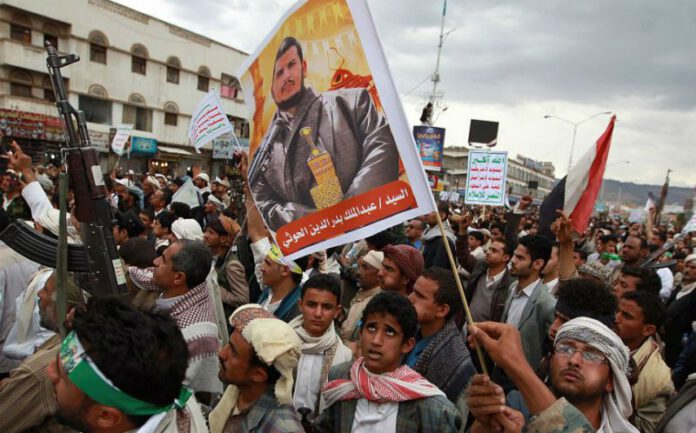Yemen’s Houthis: A new challenge to Israel’s interests in the Red Sea region and Arabian Peninsula
الأربعاء, 20 مايو 2020

By Agha Hussain
Over five years and billions of dollars’ worth of imported weaponry have gone to waste for Saudi Arabia in its war effort in Yemen. The Ansarullah movement, or ‘the Houthis’, which the Saudis tried to destroy to consolidate a client regime in Yemen has grown militarily stronger and even launched attacks deep inside Saudi territory.
For Israel, this throws a wrench in a long-term policy highly crucial to it. That is Israel’s goal to engineer, geo-economically and militarily, the region around the Red Sea and the Arabian Peninsula such that normalized ties with Israel become prudent for regional states.
Additionally, this vision, enshrined under the ambit of the Israel-[Persian] Gulf Arab (GCC) normalization and strategic partnership, would see Iran’s isolation in the region and foundations laid for an Israel-driven US war upon it.
Israel and control of the Red Sea region
A prominent milestone in Israel’s regional project was when Egypt ceded – with Israel’s permission and approval – the islands Tiran and Sanafir to Saudi Arabia in 2016.
Located at the mouth of the Gulf of Aqaba, the islands lie at the only maritime route for Israel to receive and dispatch traffic for its southern Eilat Port and directly access the Red Sea. Israel’s approval for the transfer thus represented its intent for intimate ties with the Saudis, who as the new sovereign authority in the islands would also shoulder Egypt’s obligations as per the 1979 Israel-Egypt Camp David peace pact concerning allowing Israeli vessels through the Gulf of Aqaba.
This complimented Israel’s strengthened position vis a vis the Red Sea, an enormously significant water body connecting to both Europe via the Mediterranean Sea through Egypt’s Suez Canal and to the Indian Ocean and Asia via the Bab al Mandeb Strait.
However, the strategic dimension of this region-crafting vis a vis Israel’s anti-Iran strategy is arguably more noteworthy than the regional integration with GCC-bloc Arabs.
With allies controlling and surrounding the Red Sea, Israel can institute a naval controlled blockade of the Bab al Mandab chokepoint and bar or threaten Iranian ships from entering to traverse onward to the Mediterranean. This follows Israel’s longstanding policy of isolating Iran from global markets for its hydrocarbon exports and causing its economy to stagnate. It also interferes with Iranian arms and aid shipment for Syria and Lebanon’s Hezbollah, although Iran utilizes Iraq as a land transit for that purpose as well.
Given unconditional US support for Israel and the UN’s lack of enforceable writ, international law regarding such actions would be no deterrent.
Moreover, few things would bolster this Israeli strategy more than a GCC-client regime in Yemen towing the line with regard to normalization of ties with Israel.
Yemen’s importance amidst Israel’s Red Sea region ambitions
Given that the 26 km-wide Bab al Mandab Strait lies between Yemen’s south-west and the Horn of Africa states of Eritrea and Djibouti, Yemen’s significance for Israel’s quest to dominate the Red Sea region is notable.
Israel has already invested to an extent in applying its general Iranian-boogeyman model to the Red Sea as a pretext to militarize it. In 2018, Prime Minister Benjamin Netanyahu – best known for his lies dating back to the early 1990s regarding Iran pursuing a nuclear weapons programme – cited threats by the Houthis to block the Bab al Mandab Strait as an Iranian transgression which Israel would militarily ‘respond’ to along with allied states.
Netanyahu’s assertion was fraudulent, given that the Houthis made the threat independently and in the context of the war waged upon them by the GCC. There was no Iranian threat whatsoever – only Israel’s intent to dominate the Red Sea region and isolate Iran from it.
As per this stratagem, Israel has built a military base overlooking the Bab al Mandab in Eritrea. Israeli and GCC ally Egypt also reportedly seeks agreement with Eritrea for a military base on its Nora island off Eritrea’s Red Sea coast which will supplement Saudi and UAE military-and-air bases already present in Eritrea to watch the Red Sea.
With Yemen under GCC control, Israel would effectively surround both sides of the Bab al Mandab. Diplomatic ties would quickly be established between Israel and Yemen and Israel granted ‘permission’ for naval bases on Yemen’s southwestern coast overlooking the Bab al Mandab.
Unfortunately for Israel, the Houthis’ defiance in Yemen ensures that Israel receives from the Yemen War the opposite of what it desired vis a vis the Red Sea region.
The Houthi spoiler
Today, the Houthis constitute far more than just a scapegoat for Netanyahu to justify deeper meddling in the Red Sea region. They are now an effective obstacle for Israel, possessing much territory in Yemen and an indigenous military-industrial base to go with the disarray and in-fighting among their GCC-paid mercenary-like enemies.
With the GCC to thank for igniting the Houthi-Iran alliance in the first place, the proximity of the Houthis and their drones-and-missiles arsenal to the Red Sea and Bab al Mandab acts as a deterrent to an Israeli-GCC anti-Iran blockade. Similarly, attacks upon Iranian ships in the Red Sea or approaching it via the Bab al Mandab Strait could well be met Houthi reprisals against Israel-GCC shipping or Saudi – and even UAE – territory.
This is especially plausible in current circumstances. Iran has, after all, vowed to end the US presence in the Middle East following the latter’s assassination in early January of renowned Iranian General Qassem Soleimani in Baghdad.
The likelihood of Iran coordinating action against Israeli and GCC interests in the Red Sea region is now greater – even if it is done sans any Israeli attempts to blockade the Bab al Mandab or attack Iranian ships in the Red Sea, but instead as a retaliation against US, Israeli or GCC attacks upon Iranian interests in other places altogether. Iran may even help the Houthis acquire more advanced weaponry, such as more accurate, longer-range missiles.
This Houthi deterrent, moreover, is no joke. Israel’s perpetual lust for a full-blown US-Iran war is tempered by the GCC’s Yemen War fatigue and vulnerability to both Iranian missile attacks across the Persian Gulf and from the Houthis should the US move to invade Iran. This has led to the GCC, despite ramping up ties with Israel in every way, maintaining a red line when it comes to an actual US-Iran war; the GCC were among the first to hurriedly urge the US to de-escalate tension with Iran soon after it assassinated Soleimani.
Israeli-GCC geo-economics: Connectivity projects with an added Iran War ‘bonus’
In late 2018, Israeli Transportation Minister Israel Katz pitched to Oman an Israeli-GCC regional trade corridor seeking to give the Israel-GCC alliance against Iran stronger economic foundations. The proposed railway link would connect the Mediterranean Sea via Israel to the Sea of Oman via Saudi Arabia and Oman after transiting through Jordan.
To render the project viable and expand its prospective trade volume, Israel and the GCC have pitched it to many states. Interestingly, while Israel has invited long-time ally India to trade via the new route, the GCC has also proposed to Indian adversary Pakistan to link its Chinese-operated Gwadar Port – a vital part of China’s global Belt-Road Initiative mega-project – to Oman and the Israel-GCC railway link Katz described via a ‘seabed railway tunnel or bridge’.
It is notable that the corridor seeks to terminate at the Sea of Oman instead of the Persian Gulf. In terms of economic feasibility, the latter would allow a shorter-distance (and thus cheaper to build) corridor to reach the sea which is many times cheaper and preferred by global traders to land or air transport for cargo.
The explanation for the Israel-GCC corridor’s decision to bypass the Persian Gulf is strategic and pertains to Iran.
The Persian Gulf’s Strait of Hormuz chokepoint can be threatened with blockading by Iran as a deterrent to the US attacking it. Barring Oman, the entire GCC’s (and Iran’s own) shipping – especially oil exports – needs to pass the Strait to reach global markets and a blockade would thus cripple them economically, adding to their already-present concerns vis a vis Iranian missile reprisals regardless of how many missile defense systems the US deploys in the GCC.
Should the GCC be able to re-route their oil to pass through the land-component of the Israel-GCC corridor before being exported by shipment from the Sea of Oman, they may have less to fear if an Iran invaded by the US blockades the Strait. Iran would thus become slightly more ‘invade-able’.
Israel’s quest for a US-Iran war also has the Persian Gulf’s importance to global shipping other than GCC oil exports to contend with. Considerable shipping crosses the Strait of Hormuz en route to offloading its cargo at the shores of the Persian Gulf countries, making powerful international business interests averse to the US attacking Iran and turning the Persian Gulf into a battle zone. Eager to maintain their supply chain and ensure smooth delivery of their shipped cargo to their customers, traders would lobby governments the world over against the war.
The Israel-GCC corridor’s land component seeks to counter this by linking those customers effectively to the Sea of Oman, thus ‘addressing’ the traders’ concerns vis a vis being cut off from their customers. Simultaneously with this boosting of the feasibility of the Sea of Oman route, Israel’s warmongering lobbyists in Washington will ensure the US continues militarizing the Persian Gulf and thus indirectly compels traders traditionally using the Persian Gulf into settling for the Sea of Oman alternative.
Perhaps ominously, Katz also described Iraq as part of the corridor ‘in the future’. Given the immense strategic depth Iran possesses as a deterrent to the US in Iraq through alliance with armed organizations involved in Iraqi politics, having Iraq consent to being part of an Israeli-GCC trade corridor would necessitate aggressively destroying Iran’s presence there.
It would then also involve a forced subduing of the Iraqi people through a rigid and brutal regime, considering anti-Zionism is embedded in the Iraqi national spirit itself. This can be seen from the fact that Iraqis, soon after the 2003 US invasion, began attacking Iraq’s own oil pipeline system in protest upon reports in Israeli press that a pipeline would be built from Kirkuk in Iraq to Israel’s Haifa.
Regardless, Iraq is not a necessary transit state for the corridor to materialize and its current non-conducive state to being part of it not a decisive hindrance. The Mediterranean-Sea of Oman link is possible without it as evident from the region’s map.
The challenge comes, again, from the Houthis in Yemen.
How the resilient Houthis challenge Israel’s connectivity and trade plans
For the Israel-GCC corridor, the Houthis mean bad news. Their military capabilities coupled with their proximity to Saudi Arabia – the corridor’s largest transit state – and the aforementioned likelihood of their utilization by Iran as a means of retaliation against Israeli-GCC interests pose a risk to its realization and success.
However, the Houthis’ rise exemplifies the failure of the GCC in another pursuit, separate to the Israel-GCC corridor yet also pertaining to lessening the Persian Gulf’s importance and render Iran more ‘invade-able’. Namely, GCC attempts to shift vital oil-and-shipping assets from their Persian Gulf coasts to the broad Yemeni coast – something which required the forced subduing of strong Yemeni factions such as the Houthis which would oppose such ventures and became a reason for the GCC’s initiation in March 2015 of the Yemen War.
In September 2018, the Saudis began constructing an oil pipeline from its territory through Yemen’s Oman-bordering al Mahrah governorate to the Arabian Sea. Also planned was an oil port on al Mahrah’s coastline to receive the pipeline’s oil and then export it via shipping.
The plans, seen as foreign intrusiveness, remain plagued by considerable local unrest against the Saudis – and that too in a region with historically minimal Houthi presence.
Coupled with the repeated collapse of truces between Saudi and UAE-backed forces as well as independent tribes and militias in non-Houthi territory, a situation where the GCC can safely invest in such large projects is difficult to imagine.
Even the currently-optimistic prospects for a decisive drop in hostilities, if not an official end to the Yemen War featuring some manner of UN-backed treaty, do not make these Saudi projects any more viable.
Such a ‘post-war’ scenario will carry a general feeling of a Houthi victory. After all, the GCC were practically forced toward ceasefires after devastating Houthi – or Iranian – attacks upon Saudi oil assets followed up with the subsequently hard-to-resist Houthi offers of cessation of such strikes in exchange for ceasefires.
Furthermore, the GCC lack effective domestic political challengers to the Houthis to sponsor in the ‘post-war’ scenario and thus pass their ports-and-pipelines schemes through Yemeni politics into fruition.
This lacking is far more severe for the Saudis than the UAE, given the role of brutal foreign mercenaries hired by the Saudis in the forces of the widely-unpopular Saudi-backed former President Abdur Rab Hadi in power.
The UAE, on the other hand, maintains ties with the more militarily-effective Southern Transitional Council (STC) which famously displaced Hadi in January 2018 from his then-seat in Aden after a 3 day-long battle, exemplifying lack of true unity in the GCC coalition itself. However, given that the STC seeks to partition Yemen into the North-South divide that existed from 1967-90, it may be less inclined on challenging the Houthis’ power domestically, seeing more sense in non-confrontation in exchange for de-facto ruling the territory constituting the former South Yemen while leaving the Houthis to dominate the North (whose corresponding territory they already mostly hold).
The Houthis, with internal cohesion and heightened strategic significance to Iran, will possess the greatest capacity of Yemen’s factions to exert their will in the country’s affairs. Even the STC deals with constant clashes between itself and formerly allied tribes and militias on its own turf, with rising resentment against the GCC in areas key geo-economic plans such as al Mahrah hindering it considerably. In a scenario free of overt foreign military involvement in Yemen, it cannot afford confrontation with the Houthis.
The Houthis may well become a powerful ‘veto’ force against moves to empower GCC – and thus Israeli – interests in Yemen, such as the al Mahrah pipeline and port.
Gifting Iran a new ally
The Houthis stand out as a powerful form of blowback to Israeli-GCC attempts to force their will upon major parts of the Middle East. From subjecting vital maritime trading routes to the whims of Israel’s anti-Iran crusade to bonding the GCC’s economies with that of Israel, the Houthis constitute a major spoiler.
Yemen, far from a satellite of the Israeli-GCC alliance as it was once intended to be, will only prove increasingly problematic for them in the future. For Iran, who had less of a role in the Houthis’ rise to strategic significance than did the GCC’s failed war effort, this is a boost to its regional power and set of allies it could not have foreseen itself.
Source: Websites
Y.A






